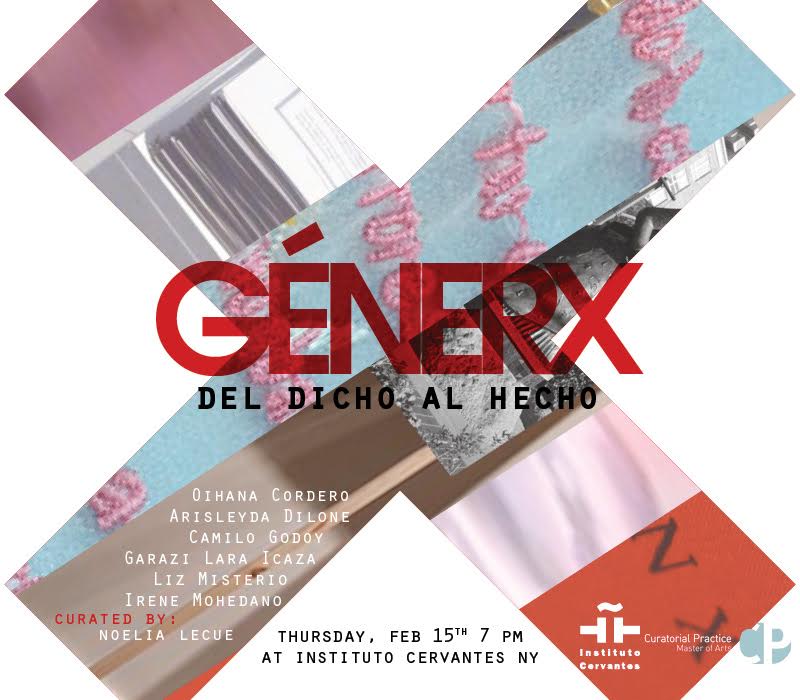Hispanic artist Irene Mohedano moved to the U.S, from Spain a mere three years ago as an intellectual scholarship recipient hoping to learn from and contribute to the New York City art scene. Leaving behind a country that no longer could support the young professional and traditionalist culture, she began to push new boundaries of art through performance and installation in the U.S.
Read MoreGénerx: del dicho al hecho. Exhibition at Instituto Cervantes New York
Instituto Cervantes is pleased to present Génerx: del dicho al hecho, a multidisciplinary exhibition based on the ideas of gender representation within the Spanish language. This show is part of #Women, a monographic program that Instituto Cervantes has organized for the first term of 2018, featuring women contributions in different artistic disciplines, the uniqueness of their work, the topics they address, and the richness of their standpoints. “The illocutionary act is one in which in saying something, one is at the same time doing something.” 1 Génerx: del dicho al hecho is an exhibition that analyzes the problematics of gender representation in the Spanish language, highlighting the connotations that underlie most binary definitions that our language has assimilated throughout its history. Currently studied in linguistics, visual arts, history, and philosophy by authors such as Judith Butler and Paul B. Preciado, gender and its representation through language influence how we analyze the construction of individual and social identity. Génerx: del dicho al hecho presents works which explore the mechanism between speech and action. The exhibition serves as a starting point from which we may reflect on the peculiarities of our language in relation to gender. For example, Spanish nouns are gendered, which can create an imbalance that results in a discriminatory discourse. The written word becomes present in the exhibition, exploring the visual and literal implications of gender. The distinction between masculine and feminine words emphasizes the different roles the two genders have in society, from both historical and modern perspectives. The binary nature of such a classification within language leaves out other possibilities and ignores the realities of genderqueer and gender fluidity. Using the word as a mediator and common thread, this exhibition presents the work of different artists whose experiences with problematic words and texts suggest opportunities for linguistic revision. Artists visualize data, analyze grammatical and cultural roots, unveil the violence behind certain words, and propone alternatives for a more neutral language.
The exhibition features works by Oihana Cordero (Spain), Arisleyda Dilone (Dominican Republic), Camilo Godoy (Colombia), Garazi Lara Icaza (Spain), Liz Misterio (México), and Irene Mohedano (Spain). Curated by Noelia Lecue Francia
En los márgenes del arte.
En los márgenes del arte is a research group investigating the boundaries in which art and other social practices merge together, to question current systems of control and domination.
Read MoreGénerx: del dicho al hecho
For the last couple of months I've been immersed in a very interesting project, suggested by curator Noelia Lecue. Everything started with two concepts: gender and language, -Spanish language, and how the difference between feminine and masculine inherent to our mother tongue shaped and framed, excluded and inscribed gender stereotypes and imbalances the collective imagery. From this perspective, I tried to find out the forms this situation is present in the context of everyday life. Now, this Gender inequality is embodied in the public space through monuments that inscribe history into public consciousness. The way in which women are represented in the public space as well as in the official discourse of history reflects socio-historical conflicts arising from the inequality between men and women. But, if you want to know more, I guess you should join us for the opening.
It's a pleasure to participate in Génerx: del dicho al hecho art exhibition with the great artists Oihana Cordero, Arisleyda Dilone, Camilo Godoy, Garazi Lara Icaza and Liz Mysterio, curated by Noelia Lecua (thanks for making the impossible happen).
Génerx: del dicho al hecho analyzes the problematic of the representation of gender in the Spanish language, highlighting the connotations that underlie most of the binary definitions that our language has assimilated throughout its history. Currently studied from linguistics, plastic arts, history or philosophy with authors such as Judith Butler or Paul B. Preciado, gender and its representation through language is an important place from which to analyze the construction of individual and social identity
Join us for the opening next Thursday, February 15th 7pm, at Instituto Cervantes, (211 E 49th St, New York).
More info here













